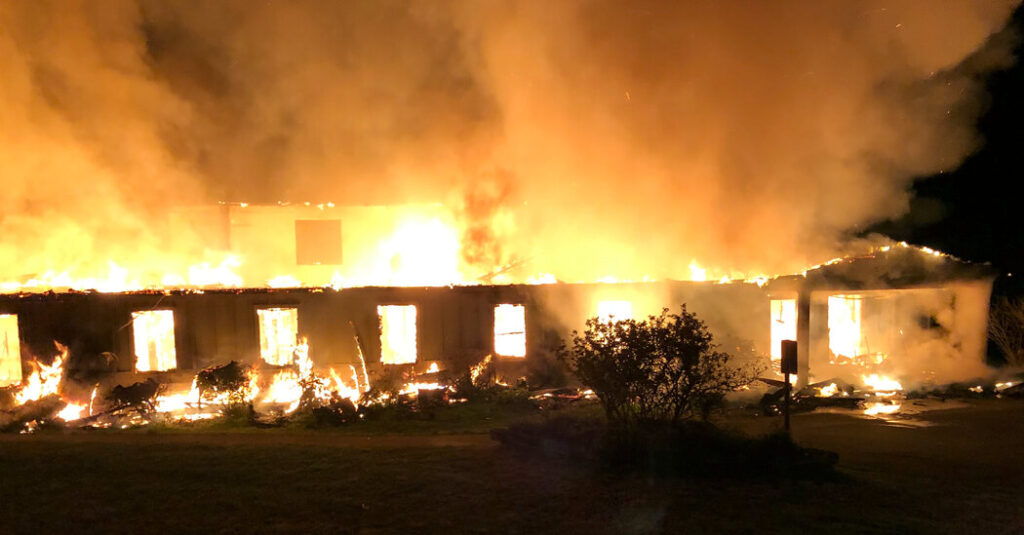An individual from Tennessee, linked to multiple white supremacist groups, has been accused of igniting a fire in 2019 that destroyed a social justice center associated with Rosa Parks and Martin Luther King Jr., according to court documents.
A federal criminal complaint made public on April 24 states that Regan Prater, 27, set fire to the main offices of the Highlander Research and Education Center located in New Market, Tennessee, close to Knoxville, and spray-painted an Iron Guard cross on the ground outside.
This symbol has roots in the fascist movements of Romania during the 1920s and 1930s, as noted by the Anti-Defamation League. Recently, it has been adopted by white supremacist groups, including an individual responsible for the deaths of 51 people in two New Zealand mosques in 2019.
Officials in Tennessee revealed that Mr. Prater, hailing from Tullahoma, acknowledged his involvement in the arson while messaging an informant on Telegram, the encrypted communication platform he used for conversations with fellow white supremacists.
“I didn’t openly admit to it, but connections can be made,” Mr. Prater allegedly responded when asked about the fire, according to the complaint.
He later discussed the details of how he ignited the fire, stating, “It was a sparkler bomb and some Napalm.”
A search of Mr. Prater’s phone revealed he had downloaded a document titled “Mad Man’s Book of Formulas,” which contained instructions for creating explosives, authorities reported. Investigators noted he had acquired gasoline, ammonium nitrate (common in cold packs), and other materials to facilitate the fire.
Hours prior to the incident, the F.B.I. indicated he searched for directions to the Highlander Center using the Waze app. After the fire, investigators found that Mr. Prater saved media images of the burning center on his phone and shared some with other white supremacists.
Mr. Prater faces a single federal charge of arson, which could result in a sentence of up to 40 years in prison. Although he was arrested on April 24 and remains in custody, a public defender assigned to him did not immediately respond to requests for comments, nor did the federal prosecutors.
In April 2021, Mr. Prater pleaded guilty to a different arson incident that occurred in June 2019 at an adult novelty store in Manchester, Tennessee. He received a five-year prison sentence followed by three years of probation. According to inmate records, he was no longer incarcerated for that case as of January.
The fire at the Highlander Center led to $1 million in damages, completely destroying its main offices in the early hours of March 29, 2019, according to officials.
Rev. Allyn Maxfield-Steele, the center’s co-executive director, shared that the building was a burnt shell when he reached the site that day.
“It was still smoking, a little bit on fire,” he recalled. “There was a sense of disbelief.”
Decades of significant documents, speeches, and artifacts were lost in the fire, some of which were from the civil rights movement—a period closely related to the center, which managed to keep its most crucial collections at other locations.
The center originated as the Highlander Folk School in Monteagle, Tennessee, in 1932, transitioning from an educational entity aimed at the poor and a supporter of labor rights into a hub for racial justice. Among its early backers was Eleanor Roosevelt.
In 1955, Ms. Parks participated in a civil rights workshop there just weeks before her iconic refusal to surrender her bus seat to a white passenger, an act that sparked the Montgomery bus boycott.
She returned to Highlander in 1957 when Dr. King delivered the closing speech at a conference celebrating the school’s 25th anniversary.
In 1958, celebrated civil rights leader John Lewis attended a retreat at Highlander as well. Lewis, who later served in Congress until his passing in 2020, mentioned in his memoir that it was an invaluable experience.
Reflecting on his time at Highlander, he noted, “It was the first occasion I saw Black and white individuals not just dining together, but also collaborating to clean up afterward, engaging in discussions late into the night.”
Now, six years after the fire, the center is nearing the completion of its main office reconstruction, which Mr. Maxfield-Steele anticipates will be finished by year-end.
Mr. Maxfield-Steele, who is white, commented that the fire has only strengthened the determination of the organization.
“What does it imply,” he questioned, “that such acts persist?”


